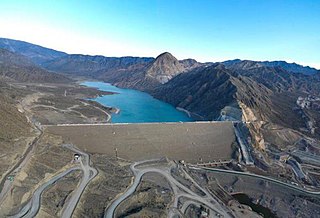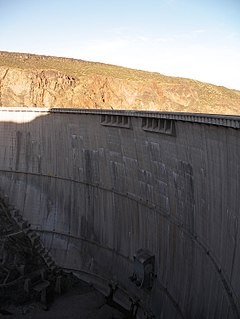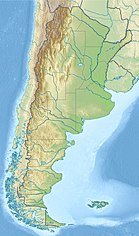
Hydroelectricity is electricity produced from hydropower. In 2015, hydropower generated 16.6% of the world's total electricity and 70% of all renewable electricity, and was expected to increase about 3.1% each year for the next 25 years.

The Ilısu Dam is a concrete-face rock-fill dam on the Tigris near the village of Ilısu and along the border of Mardin and Şırnak Provinces in Turkey. It is one of the 22 dams of the Southeastern Anatolia Project and its purpose is hydroelectric power production, flood control and water storage. When operational, the dam will support a 1,200 MW power station and will form a 10.4 billion m3 reservoir. Construction of the dam began in 2006 and was originally expected to be completed by 2016. As part of the project, the much smaller Cizre Dam is to be constructed downstream for irrigation and power. The dam has drawn international controversy, because it will flood portions of ancient Hasankeyf and necessitate the relocation of people living in the region. Because of this, the dam lost international funding in 2008. Kurdish Kurdistan Workers' Party militants have also attacked infrastructure associated with the dam which led to construction delays.

The Quebrada de Ullúm Dam, or simply Ullúm Dam, is an embankment dam on the San Juan River, just west of San Juan in Ullúm Department of the Province of San Juan, Argentina. It is located at the gorge of the Quebrada de Ullum, 18 kilometres (11 mi) upstream from the provincial capital San Juan, and creates a reservoir with an area of 32 square kilometres (12 sq mi), a volume of 440 million cubic metres, and average and maximum depths of 15 and 40 metres, respectively. The reservoir feeds a hydroelectric power station with an installed power capacity of 45 megawatts (60,000 hp).

Pangue Hydroelectric Plant is a hydroelectric power station in Bío Bío Region, Chile. It lies west of Callaqui volcano at the confluence of the rivers Pangue and Huiri-Huiri. The plant uses water from the upper Bío Bío River and produces 467 megawatts (626,000 hp) of electricity. The plant was built by Endesa in 1996.

The Mingtan Dam is a dam that spans the Shuili River about 4 km (2.5 mi) downstream from the outlet of Sun Moon Lake in central Taiwan with a height of about 61.5 m (202 ft). It forms Mingtan Reservoir which is the lower reservoir for the Mingtan Pumped Storage Hydro Power Plant.

The La Grange Dam is a masonry-gravity diversion dam on the Tuolumne River near La Grange, California. The dam was completed in 1883 by the Turlock Irrigation District and Modesto Irrigation District in an effort to divert water into their canal systems for local farmers.
The Beles Hydroelectric Power Plant, sometimes referred to as Beles II or Tana Beles, is a run-of-the-river hydroelectric power plant in Ethiopia near Lake Tana. The power plant receives water from the lake through the Tana-Beles interbasin transfer and after utilizing it to produce electricity, the water is then discharged into the Beles River. The plant has an installed capacity of 460 MW and it is the second largest power plant in the country. It is also expected to help provide water for the irrigation of 140,000 ha. It was inaugurated in May 2010 and the last generator was operational in February 2012. Its construction was negatively perceived by downstream Egypt.

The Longyangxia Dam is a concrete arch-gravity dam at the entrance of the Longyangxia canyon on the Yellow River in Gonghe County, Qinghai Province, China. The dam is 178 metres (584 ft) tall and was built for the purposes of hydroelectric power generation, irrigation, ice control and flood control. The dam supports a 1,280 MW power station with 4 x 320 MW generators that can operate at a maximum capacity of 1400 MW. Controlling ice, the dam controls downstream releases to reservoirs lower in the river, allowing them to generate more power instead of mitigating ice. Water in the dam's 24.7 billion m3 reservoir provides irrigation water for up to 1,000,000 hectares of land.

The Daguangba Dam is a multi-purpose dam on the Changhua River in Hainan Province, China. It is located 35 km (22 mi) east of Dongfang. As the primary component of the Daguangba Multipurpose Project, the dam was constructed between 1990 and 1995. It serves to provide water for both hydroelectric power generation and agriculture. It supports a 240 MW power station and supplies water for the irrigation of 12,700 ha. It is also the largest dam and hydroelectric power station in Hainan.

The Alpaslan-2 Dam is an embankment dam currently under construction on the Murat River in Muş Province, Turkey. The dam is located about 32 km (20 mi) north of the provincial capital, Muş. The primary purpose of the dam is hydroelectric power production and irrigation. Its power station will have an installed capacity of 280 MW and the reservoir will help irrigate 78,000 ha of land. Enerjisa Power Generation Inc. acquired the license for the power station from Özışık İnsaat & Enerji in April 2011 and Yenigün Construction started excavating the diversion tunnels May 2012. The diversion tunnels are expected to be complete by the end of 2012. In late May 2013 Pöyry was awarded the detailed design of the dam, power station, spillway and switch yard. Enerjisa expects the project to be complete in 2016.

The Kavşak Bendi Dam is a concrete-face rock-fill dam on the Seyhan River bordering Kozan and Aladağ districts in Adana Province, Turkey. Construction on the dam began in 2008 and the first generator was commissioned in 2013. The two remaining generators were commissioned by April 2014. The primary purpose of the dam is hydroelectric power generation. Water is sent about 2.5 km (1.6 mi) downstream where it meets the power station which contains three 59 MW Francis turbine-generators.

Potrerillos Dam is located on the Mendoza River, in Argentina's Potrerillos Valley. The dam was built between 1999 and 2003 by a consortium consisting of Industrias Metalúrgicas Pescarmona (IMPSA) and Cartellone to provide flood control, hydroelectricity and irrigation water. The dam cost US$ 312 million to construct. Located about 30 kilometres (19 mi) southwest of Mendoza, the concrete-faced rockfill dam is 116 metres (381 ft) high and 395 metres (1,296 ft) long, impounding the 12 km (7.5 mi) long Potrerillos Reservoir.

The Bowatenna Dam is a 100 ft (30 m) high gravity dam at Bowatenna, in the Central Province of Sri Lanka. The dam was built in June 1981, and is used primarily for irrigation. A 40 MW power station is also constructed 5,800 ft (1,800 m) downstream, for hydroelectric power generation.

The Gal Oya Dam is an embankment dam in the Uva Province of Sri Lanka. The dam creates one of the largest and most iconic reservoirs in the country, the Gal Oya Reservoir. Water from the reservoir is used primarily for irrigation in the Uva and Eastern provinces, in addition to powering a small hydroelectric power station. Construction of the dam and reservoir began in August 24, 1949, completing four years later in 1953.

The Nangbeto Dam is an embankment dam on the Mono River in the Plateaux Region of Togo. It was constructed between 1984 and 1987 for the purpose of providing hydroelectric power to both Togo and Benin as well as creating fisheries and supplying water for irrigation. The dam's 65.6 megawatts (88,000 hp) power station was commissioned in June 1987. The project was financed by the World Bank and African Development Bank at a cost of US$98.22 million.

The Monción Dam is an earth-fill embankment dam on the Mao River near Monción in Santiago Rodríguez Province of the Dominican Republic. At 119 m (390 ft) tall, it is the highest dam in the country. The purpose of the dam is to produce hydroelectric power and supply water for irrigation. The dam's power station is located downstream and contains two 26 MW Francis turbine-generators for an installed capacity of 52 MW. The dam was completed and began filling its reservoir on 22 September 2001. Its power station was commissioned on 27 April 2002.

The Punta Negra Dam is a concrete-face rock-fill dam on the San Juan River about 28 kilometres (17 mi) west of San Juan in San Juan Province, Argentina. The purpose of the dam is to provide water for irrigation and the generation of hydroelectric power. The 101 metres (331 ft) tall dam supports a 62-megawatt (83,000 hp) power station and together with the Los Caracoles Dam upstream, it will provide for the irrigation of 15,000 hectares. Construction began in 2009 and the dam and was finished in August 29, 2015. It is being constructed immediately upstream of an diversion barrage.

The La Viña Dam, officially known as the Antonio Medina Allende Dam, is an arch dam on the Los Sauces River in San Alberto Department of Córdoba Province, Argentina. Construction on the dam began in 1938 and it was completed in 1944. The 16 MW (21,000 hp) power station was later connected to the grid on 28 February 1959. Aside from generating hydroelectric power, water stored by the dam is used to irrigate around 24,000 ha of farmland.

The Agua del Toro Dam is an arch dam on the Diamante River about 63 kilometres (39 mi) west of San Rafael in Mendoza Province, Argentina. The primary purpose of the dam is hydroelectric power generation and it supports a 150 megawatts (200,000 hp) power station located downstream. Construction on the dam began in 1966 and it was completed in 1973. The power station was started the same year and commissioned in 1982. The dam and power station is part of the Rio Diamante System which is owned jointly by Hidroeléctrica Diamante (HIDISA) and Hidroeléctrica de los Nihuiles (HINISA).





















